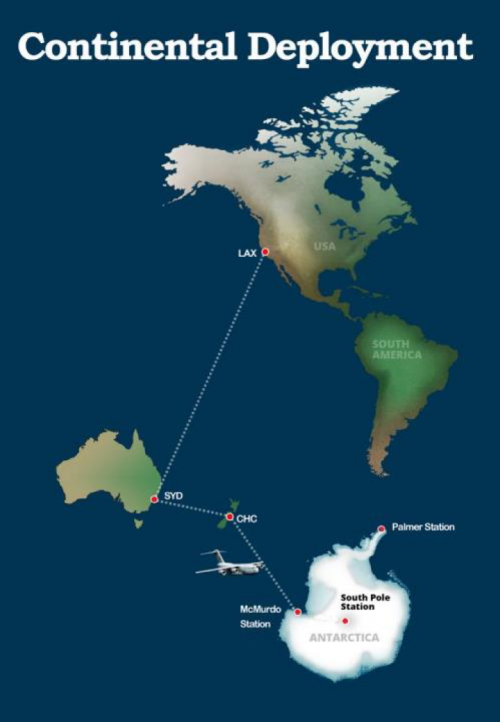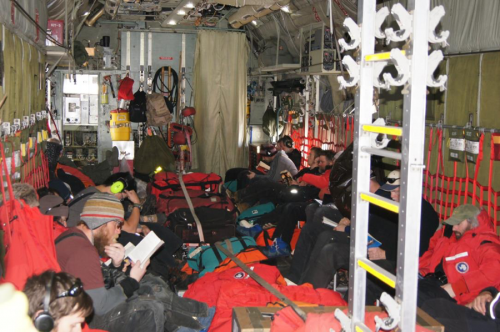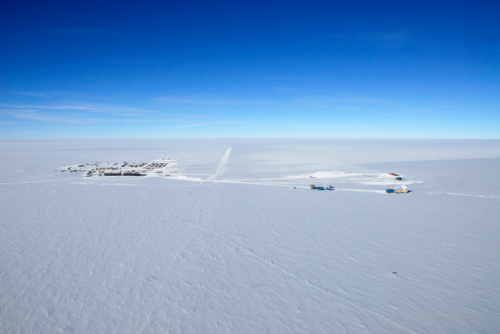With my deployment dates set for January 2017, the United States Antarctic Program (USAP) is working hard to figure out the logistics of how to get me to the South Pole.
Hang onto your passports folks, it’s going to be a long journey!
Getting to New Zealand
There are two main ways to get to Antarctica as a research scientist:
- Through Punta Arenas, Chile. If you’re deploying to Palmer Station, you’d head through Punta Arenas. Special shout out to Mrs. Kane, a teacher-researcher currently on expedition as part of NASA’s Operation IceBridge. She departed from Punta Arenas. Follow her expedition here
- Through Christchurch, New Zealand. If you’re heading to McMurdo or Amundson-Scott South Pole Stations (like I am!), you’d head through Christchurch.
 A map showing the flights from Los Angeles to Sydney, Australia to Christchurch, New Zealand to McMurdo Station. I will have one more flight that isn't shown from McMurdo Station to the South Pole Station. Photo Credit: National Science Foudnation
A map showing the flights from Los Angeles to Sydney, Australia to Christchurch, New Zealand to McMurdo Station. I will have one more flight that isn't shown from McMurdo Station to the South Pole Station. Photo Credit: National Science Foudnation
Although the details are still being finalized, I’ll probably hop on a flight from Washington, D.C. to Los Angeles. From there, I’ll fly through either Sydney or Auckland, Australia. Finally, I’ll fly into Christchurch, New Zealand.
As I fly, I’ll cross the International Date Line, meaning I will lose one whole day while traveling.
I’m already planning on downloading some e-books, updating my iTunes library, and packing an inflatable pillow. That’s going to be a long, tiring travel day(s)!
Then, I’ll spend a few days in New Zealand for final preparations. I’ll get fitted for my Extreme Cold Weather (ECW) gear and re-pack to ensure my bags meet the strict weight requirements.
Getting to McMurdo
When it’s time to catch my flight to McMurdo, I’ll change out of my street clothes and into the ECW. I’ll board an LC-130 aircraft for a 7-8 hour flight. Not too bad, right?
 This picture captures a typical flight from Christchurch, New Zealand to McMurdo Station. Photo Credit: National Science Foundation
This picture captures a typical flight from Christchurch, New Zealand to McMurdo Station. Photo Credit: National Science Foundation
Maybe I forgot to mention that this flight doesn’t come with pretzels and your choice of juice or soda. We’ll be sitting in the cargo compartment with boxes of supplies and scientific equipment heading to Antarctica. The bathroom consists of a seat that folds down over a bucket with a shower curtain around it. And it is so loud people usually don’t, or can’t, talk to one another.
Hey, no one ever said doing super-cool science in a remote location was a glorious job!
After landing at McMurdo, I’ll board a van or a bus to get into “town” where I’ll be briefed for about an hour. I’ll likely stay in McMurdo for a few days waiting for my flight to the Pole.
Getting to the South Pole
Assuming the weather holds out (which is an optimistic assumption when you’re in Antarctica), I should hop on an LC-130 flight to the South Pole within a few days. This flight is only about 3 hours and I hear it’s beautiful to look out of the window. I look forward to posting pictures for you!
 An aerial view of the South Pole Station. Photo Credit: National Science Foudnation
An aerial view of the South Pole Station. Photo Credit: National Science Foudnation
Expect the Unexpected
While this is the plan right now, the one piece of advice I keep hearing over and over is to expect the unexpected. In addition to the array of delays that you might experience with normal air travel, I have to remember this is Antarctica. Delays will happen, priorities will shift, and I’ll go with the flow, knowing I’m in good hands with the PolarTREC and USAP teams behind me.
Questions?
Do you have a question about Antarctica, project IceCube, or anything else about my expedition? Post in the comments section below and I’ll get back to you!


Comments